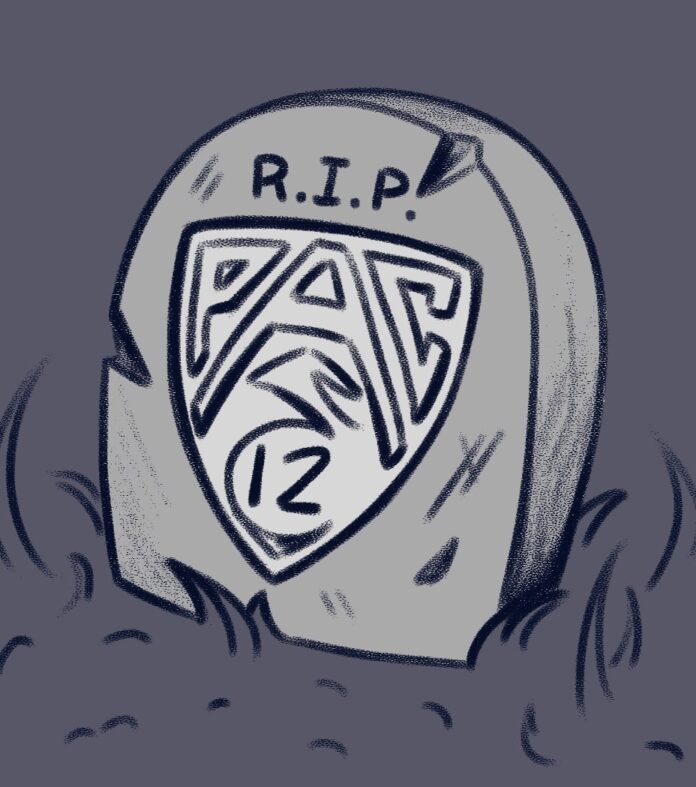By George Schroeder | LTVN Executive Producer
It’s a cool Saturday night in November and your team won its game earlier in the day. You just got done watching a huge Big Ten matchup in the afternoon window, and you simply need more college football. You’re in luck, because Oregon State University is taking on the University of Washington on ESPN2, and the game just started.
Maybe it’s the late nights. Maybe it’s the physical matchups, or maybe it’s the Chip Kelly-inspired quick-tempo play style. Maybe it’s just because I grew up a fan of the University of Oregon. Whatever it is, something makes Pac-12 football fun.
There’s something to be said for the football conference, which extends beyond the Rocky Mountains. Call me a Pac-12 homer, but it’s a shame we’re losing the Conference of Champions.
Its history rivals any other, dating back over 100 years to 1915 and the creation of the Pacific Coast Conference. Since its birth, the conference has boasted 22 national football titles and 11 Heisman Trophy winners while holding a bowl win percentage of .508 (152-147-5) — and that’s just in football alone. With a total of 553, the Pac-12 holds more NCAA titles than any other conference in America.
It’s not just about history. From one of the most iconic college mascots — the Duck — riding a motorcycle into Autzen Stadium, to Ralphie’s run on Folsom Field, to Washington State University’s iconic crimson flag flying in the crowd on every episode of ESPN’s College GameDay, there’s been no shortage of tradition.
Unfortunately, schools have to follow the money. It’s hard to even blame them at this point. Be honest, you know football programs support the entire athletic department. Programs had to leave for their own good, and however you feel about it, what led them to the point of departure isn’t a story for this article.
Once the University of Colorado announced its move to the Big 12, I knew the Pac-12 was done for. Losing the University of Southern California and the University of California – Los Angeles was already a major blow to a conference that hasn’t sent a team to the playoffs in seven years, but a “Pac-9” would have been totally unsustainable.
The Big Ten opened the door to the ultimate implosion of the Pac-12 during the summer of 2022. After the Trojans and Bruins jumped ship, Big 12 Commissioner Brett Yormark made major moves to stabilize his conference, eating away the Pac-12 in the process.
You don’t have to live in the Pacific Standard Time zone to understand two things can be true at once. In the wake of conference expansion, the Big 12 had the means, motive and opportunity to survive and advance. However, even someone affiliated to Yormark’s league can feel the sting of the Pac-12’s collapse.
“I think it’s exciting and it’s sad,” Baylor football head coach Dave Aranda said.
Baylor’s conference is about to be bigger, stronger and more competitive than it has ever been, and we’re not even talking about the implications on basketball. It’s an exciting time for the Big 12, but it’s also sad that the Pac-12 had to be sacrificed to achieve conference stability.
“I remember going to the Rose Bowl,” Aranda said. “I remember watching USC games with my dad. I remember when Washington went to the Rose Bowl. I remember when the Badgers beat the Bruins.”
I’m going to miss those things too, and so is Baylor Bear Insider Jerry Hill, who’s also the director of Bear Foundation Communications and the director of sports journalism at Baylor. He has been covering college sports for over 35 years.
“When you [think of] traditional football powers around the country, you think of USC, [and] to a certain extent, more recently, you think of Oregon with all flash,” Hill said. “I’m going to miss that part of it, particularly with the tie-in with the Rose Bowl.”
“A little old school” is Hill’s way of expressing his sentiment, but you don’t need decades of experience in sports media to appreciate the regionality the Power Five conferences captured. It’s just as important as the history and tradition of the Pac-12.
“It was really that Pacific and Pacific Northwest Conference, you know, ‘Pac-12,’” Hill said. “That’s the part I’m going to miss the most.”
It’s going to take some getting used to not having that late-night fight on the Pacific gridiron. College football is so great, and there’s just so much I’ll miss about growing up in the era of the Power Five.
The Big 12 will soon span over 2,000 miles and three time zones, containing 16 teams. Meanwhile, the Big Ten literally extends coast-to-coast, stretching across four time zones and almost 3,000 miles, consisting of 18 teams. Good luck traveling to away games.
So prepare for the era of the Power Four mega conferences, and — unfortunately — college football without a Pacific conference.
Who knows, maybe 20 years from now we’ll be talking about the new West Coast Conference reviving the Conference of Champions and bringing “normal” back to college football.
As we move forward into a new and exciting time in the Big 12, taking our first step into wherever conference expansion is leading college football, don’t forget the history, tradition and success of the Pac-12.
I’m not sure about you, but I’ll be savoring its last year while looking forward to the strength of Baylor’s revamped conference.






